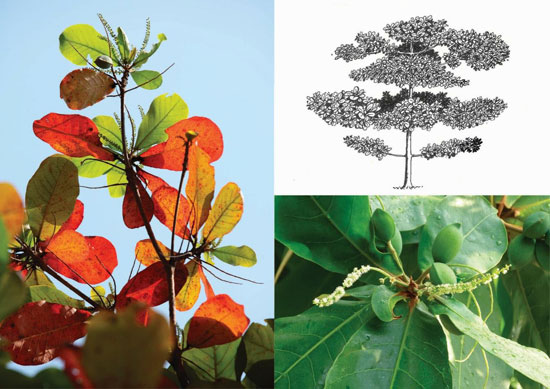Colourful Kottang
Terminalia catappa
 Common/ English name: Country almond
Common/ English name: Country almond- Family: Combretaceae
(The kumbuk/marudu family)
(Sinhala name: Kottamba/Kottang; Tamil name: Kottai)
This tree is not as spectacular as the Flamboyant or the Tabebuia but it is still a beautiful tree, with large, oval-shaped leaves clustered in whorls, with branches spreading horizontally and arranged in tiers, giving this tree a very distinct appearance.

Easily recognisable from the horizontal spread of its branches, arranged in whorls and from the brightly-coloured leaves (reds and yellows), when they are about to drop. Photograph left © Luxshmanan Nadaraja; top right: illustration by P. A. Miththapala; above right: Author
This species is native to Malaysia and the Andaman Islands and was introduced to
Sri Lanka from India. It is a common tree of the humid, low-country wet zone, planted along urban roadsides to provide shade. It sheds its leaves about twice a year. Then, the leaves turn from green to yellow to vermilion to crimson, lighting up this already lovely tree.
The flowers are small, white and star-shaped, arranged along thin, slightly curved bunches. Fruits are hard, ellipse-shaped and flattened. There is one seed per fruit, surrounded by an edible kernel, which tastes like almonds, hence the common name.
In my childhood, these fruits were something I picked up and ate but now I know that this tree is an important food source in urban settings for fruit-eaters, such as fruit bats.
Extracted from ‘What tree is that? The Ruk Rakaganno Layperson’s Guide to Some Trees of Sri Lanka’. Updated by the author using ‘Grown in Sri Lanka: cultivated flowering plants’ by Sriyanie Miththapala, Janaki Galappatti, and Siril Wijesundara (2015). The National Trust: Colombo.
Searching for an ideal partner? Find your soul mate on Hitad.lk, Sri Lanka's favourite marriage proposals page. With Hitad.lk matrimonial advertisements you have access to thousands of ads from potential suitors who are looking for someone just like you.


